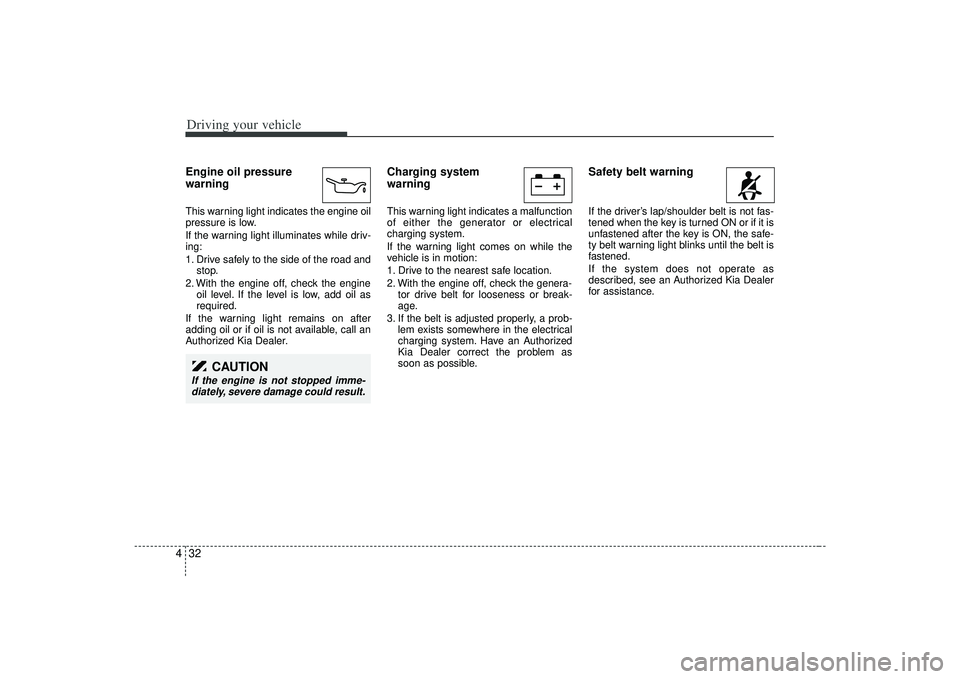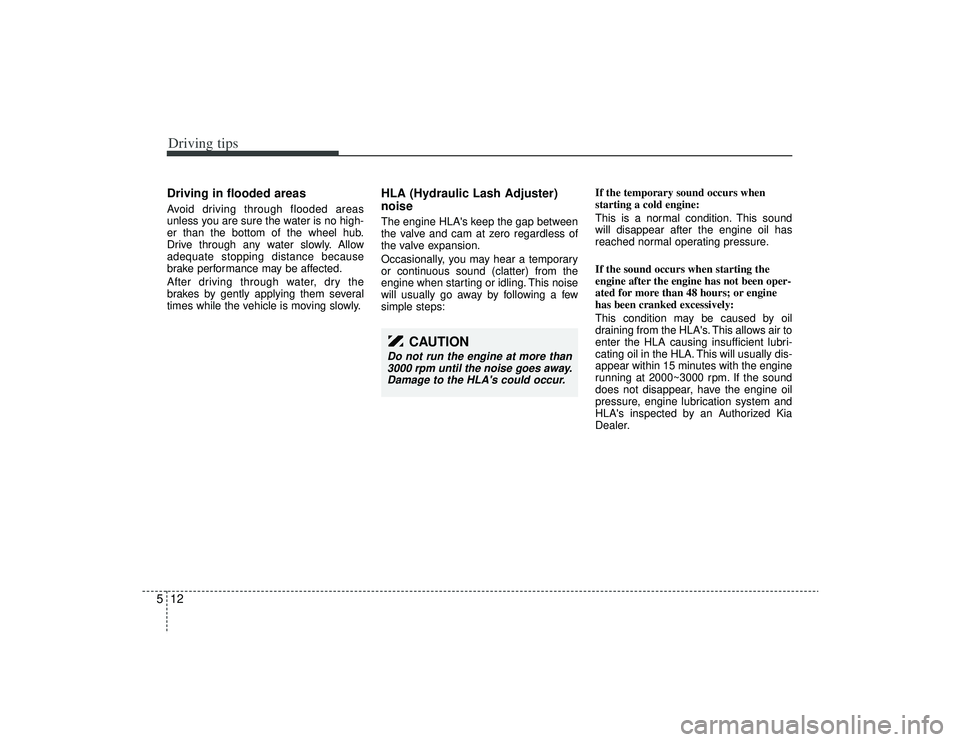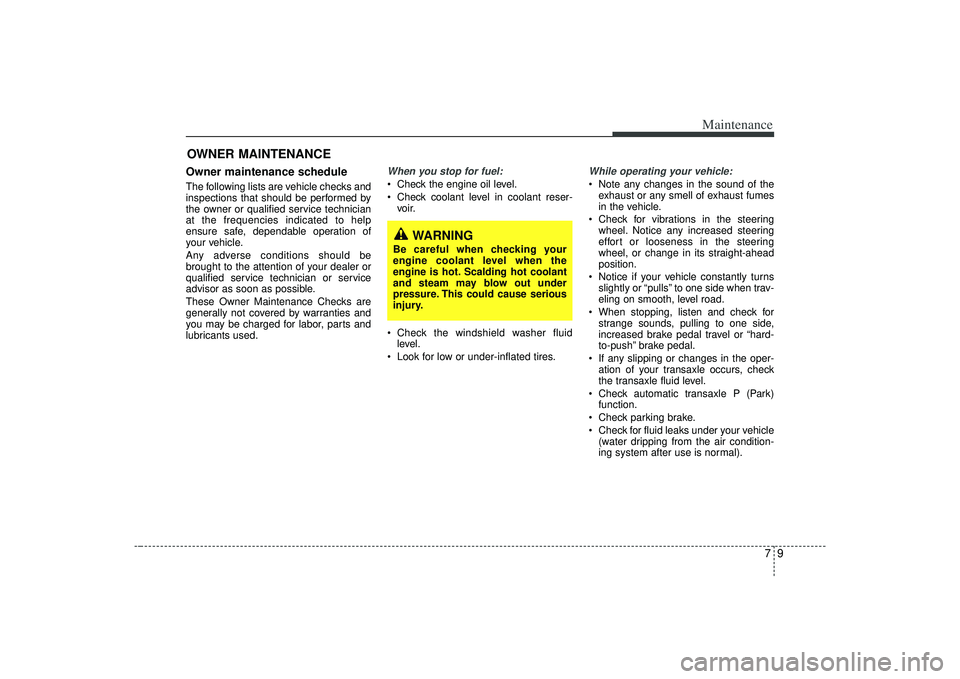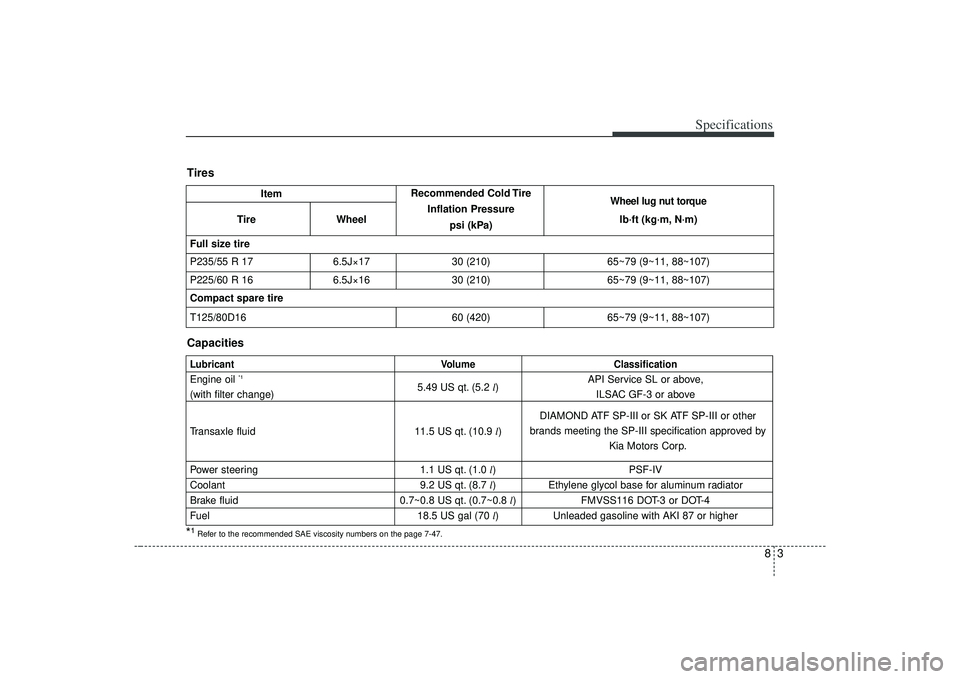2009 KIA AMANTI oil pressure
[x] Cancel search: oil pressurePage 1 of 321

Gasoline
UNLEADED gasoline
AKI (Anti-Knock Index) 87 or higher
Fuel Tank Capacity
18.5 gal. (70 liters)
Recommended Engine Oil
API Service SL or above,
ILSAC GF-3 or above
Engine Oil Capacity with Filter
5.49 qts. (5.2 liters)
Engine Coolant
9.2 qts. (8.7 liters)
Tire Pressure (measured cold)
P225/60R16 : 30 psi
P235/55R17 : 30 psi
Compact Spare Tire PressureT125/80D16 : 60 psiAutomatic Transaxle FluidDIAMOND ATF SP-III or SK ATF SP-III
or other brands meeting the SP-III speci-
fication approved by Kia Motors Corp. Capacity : 11.5 qts. (10.9 liters)
Brake Fluid
FMVSS116 DOT-3 or DOT-4
Power Steering Fluid
PSF-IV
GAS STATION INFORMATION
Page 168 of 321

Driving your vehicle32
4Engine oil pressure
warning This warning light indicates the engine oil
pressure is low.
If the warning light illuminates while driv-
ing:
1. Drive safely to the side of the road and
stop.
2. With the engine off, check the engine oil level. If the level is low, add oil as
required.
If the warning light remains on after
adding oil or if oil is not available, call an
Authorized Kia Dealer.
Charging system
warning This warning light indicates a malfunction
of either the generator or electrical
charging system.
If the warning light comes on while the
vehicle is in motion:
1. Drive to the nearest safe location.
2. With the engine off, check the genera- tor drive belt for looseness or break-
age.
3. If the belt is adjusted properly, a prob- lem exists somewhere in the electrical
charging system. Have an Authorized
Kia Dealer correct the problem as
soon as possible.
Safety belt warning If the driver’s lap/shoulder belt is not fas-
tened when the key is turned ON or if it is
unfastened after the key is ON, the safe-
ty belt warning light blinks until the belt is
fastened.
If the system does not operate as
described, see an Authorized Kia Dealer
for assistance.
CAUTION
If the engine is not stopped imme-diately, severe damage could result.
Page 204 of 321

Driving tips12
5Driving in flooded areas Avoid driving through flooded areas
unless you are sure the water is no high-
er than the bottom of the wheel hub.
Drive through any water slowly. Allow
adequate stopping distance because
brake performance may be affected.
After driving through water, dry the
brakes by gently applying them several
times while the vehicle is moving slowly.
HLA (Hydraulic Lash Adjuster)
noiseThe engine HLA's keep the gap between
the valve and cam at zero regardless of
the valve expansion.
Occasionally, you may hear a temporary
or continuous sound (clatter) from the
engine when starting or idling. This noise
will usually go away by following a few
simple steps: If the temporary sound occurs when
starting a cold engine:
This is a normal condition. This sound
will disappear after the engine oil has
reached normal operating pressure.
If the sound occurs when starting the
engine after the engine has not been oper-
ated for more than 48 hours; or engine
has been cranked excessively:
This condition may be caused by oil
draining from the HLA's. This allows air to
enter the HLA causing insufficient lubri-
cating oil in the HLA. This will usually dis-
appear within 15 minutes with the engine
running at 2000~3000 rpm. If the sound
does not disappear, have the engine oil
pressure, engine lubrication system and
HLA's inspected by an Authorized Kia
Dealer.
CAUTION
Do not run the engine at more than
3000 rpm until the noise goes away. Damage to the HLA's could occur.
Page 226 of 321

63
In case of an emergency
3. Have all passengers get out of the car.Be sure they all get out on the side of
the car that is away from traffic.
4. When changing a flat tire, follow the instruction provided later in this sec-
tion.If engine stalls while driving1. Reduce your speed gradually, keepinga straight line. Move cautiously off the
road to a safe place.
2. Turn on your emergency flashers.
3. Try to start the engine again. If your vehicle will not start, contact an
authorized KIA dealer or seek other
qualified assistance. If your temperature gauge indicates over-
heating, if you experience a loss of
power, or if you hear a loud knocking or
pinging noise, the engine has probably
overheated. Should any of these symp-
toms occur, use the following procedure:
1. Turn on the hazard warning flasher,
then drive to the nearest safe location
and stop your vehicle; set the automat-
ic transaxle in P (Park) and apply the
parking brake.
2. Make sure the air conditioner is off.
3. If coolant or steam is boiling out of the radiator, stop the engine and call an
Authorized Kia Dealer for assistance.
If coolant is not boiling out, allow the
engine to idle and open the hood to
permit the engine to cool gradually.
If the temperature does not go down
with the engine idling, stop the engine
and allow sufficient time for it to cool. 4. The coolant level should then be
checked. If the level in the reservoir is
low, look for leaks at the radiator hoses
and connections, heater hoses and
connections, radiator, and water
pump. If you find a major leak or anoth-
er problem that may have caused the
engine to overheat, do not operate the
engine until it has been corrected. Call
an Authorized Kia Dealer for assis-
tance. If you do not find a leak or other
problem, carefully add coolant to the
reservoir.
If the engine frequently overheats, havethe cooling system checked and repaired by an Authorized Kia Dealer.
WARNING
- Removing
radiator cap
Do not remove the radiator cap
when the engine and radiator are
hot. Scalding hot coolant and steam
may blow out under pressure. This
could cause serious injury.
OVERHEATING
Page 259 of 321

79
Maintenance
OWNER MAINTENANCE Owner maintenance schedule The following lists are vehicle checks and
inspections that should be performed by
the owner or qualified service technician
at the frequencies indicated to help
ensure safe, dependable operation of
your vehicle.
Any adverse conditions should be
brought to the attention of your dealer or
qualified service technician or service
advisor as soon as possible.
These Owner Maintenance Checks are
generally not covered by warranties and
you may be charged for labor, parts and
lubricants used.
When you stop for fuel: Check the engine oil level.
Check coolant level in coolant reser-voir.
Check the windshield washer fluid level.
Look for low or under-inflated tires.
While operating your vehicle: Note any changes in the sound of the exhaust or any smell of exhaust fumes
in the vehicle.
Check for vibrations in the steering wheel. Notice any increased steering
effort or looseness in the steering
wheel, or change in its straight-ahead
position.
Notice if your vehicle constantly turns slightly or “pulls” to one side when trav-
eling on smooth, level road.
When stopping, listen and check for strange sounds, pulling to one side,
increased brake pedal travel or “hard-
to-push” brake pedal.
If any slipping or changes in the oper- ation of your transaxle occurs, check
the transaxle fluid level.
Check automatic transaxle P (Park) function.
Check parking brake.
Check for fluid leaks under your vehicle (water dripping from the air condition-
ing system after use is normal).
WARNING
Be careful when checking your
engine coolant level when the
engine is hot. Scalding hot coolant
and steam may blow out under
pressure. This could cause serious
injury.
Page 288 of 321

Maintenance38
7Cold Tire Pressure: The amount of
air pressure in a tire, measured in
pounds per square inch (psi) or kilo-
pascals (kPa) before a tire has built
up heat from driving.
Curb Weight: This means the weight
of a motor vehicle with standard and
optional equipment including the
maximum capacity of fuel, oil and
coolant, but without passengers and
cargo.
DOT Markings: A code molded into
the sidewall of a tire signifying that
the tire is in compliance with the U.S.
Department of Transportation motor
vehicle safety standards. The DOT
code includes the Tire Identification
Number (TIN), an alphanumeric des-
ignator which can also identify the
tire manufacturer, production plant,
brand and date of production.
GVWR: Gross Vehicle Weight Rating
GAWR FRT: Gross Axle Weight
Rating for the front Axle.
GAWR RR: Gross Axle Weight
Rating for the rear axle. Intended Outboard Sidewall
: The
side of an asymmetrical tire, that
must always face outward when
mounted on a vehicle.
Kilopascal (kPa): The metric unit for
air pressure.
Load Index: An assigned number
ranging from 1 to 279 that corre-
sponds to the load carrying capacity
of a tire.
Maximum Inflation Pressure : The
maximum air pressure to which a
cold tire may be inflated. The maxi-
mum air pressure is molded onto the
sidewall.
Maximum Load Rating : The load
rating for a tire at the maximum per-
missible inflation pressure for that
tire.
Maximum Loaded Vehicle Weight:
The sum of curb weight; accessory
weight; vehicle capacity weight; and
production options weight.
Normal Occupant Weight:The
number of occupants a vehicle is
designed to seat multiplied by 150
pounds (68 kg). Occupant Distribution
: Designated
seating positions.
Outward Facing Sidewall: The side
of a asymmetrical tire that has a par-
ticular side that faces outward when
mounted on a vehicle. The outward
facing sidewall bears white lettering
or bears manufacturer, brand, and/or
model name molding that is higher or
deeper than the same moldings on
the inner facing sidewall.
Passenger (P-Metric) Tire : A tire
used on passenger cars and some
light duty trucks and multipurpose
vehicles.
Recommended Inflation Pressure :
Vehicle manufacturer's recommend-
ed tire inflation pressure and shown
on the tire placard.
Radial Ply tire: A pneumatic tire in
which the ply cords that extend to the
beads are laid at 90 degrees to the
centerline of the tread.
Rim: A metal support for a tire and
upon which the tire beads are seat-
ed.
Sidewall: The portion of a tire
between the tread and the bead.
Page 305 of 321

83
Specifications
LubricantVolume ClassificationEngine oil
*1
5.49 US qt. (5.2 l) API Service SL or above,
(with filter change) ILSAC GF-3 or above
Transaxle fluid 11.5 US qt. (10.9 l)
Power steering 1.1 US qt. (1.0 l) PSF-IV
Coolant 9.2 US qt. (8.7 l)Ethylene glycol base for aluminum radiator
Brake fluid 0.7~0.8 US qt. (0.7~0.8 l)FMVSS116 DOT-3 or DOT-4
Fuel 18.5 US gal (70 l)Unleaded gasoline with AKI 87 or higher
*¹Refer to the recommended SAE viscosity numbers on the page 7-47.
DIAMOND ATF SP-III or SK ATF SP-III or other
brands meeting the SP-III specification approved by Kia Motors Corp.
Tires
Item Recommended Cold Tire
Wheel lug nut torque
Tire Wheel Inflation Pressure
psi (kPa) lb·ft (kg·m, N·m)
Full size tire
P235/55 R 17 6.5J×1730 (210) 65~79 (9~11, 88~107)
P225/60 R 16 6.5J×1630 (210) 65~79 (9~11, 88~107)
Compact spare tire
T125/80D16 60 (420)65~79 (9~11, 88~107)
Capacities
Page 315 of 321

Index4
10
your Vehicle ··················\
··················\
··················\
·············4-1
Winter ··················\
··················\
··················\
··················\
····5-9
with a Trailer ··················\
··················\
··················\
·········5-21
Economical Operation, Suggestions for ··················\
········5-6
Electrical Circuit Protection ··················\
··················\
··················\
····6-6
Equipment··················\
··················\
··················\
················9-4
Electronic Stability Control ··················\
··················\
·······4-22
Emergency In Case of an··················\
··················\
··················\
············6-1
Roadside Assistance ··················\
··················\
··················\
9-2
Starting··················\
··················\
··················\
··················\
···6-4
Emission Control System ··················\
··················\
············5-3
Engine Compartment ··················\
··················\
··················\
··2-4, 7-12
Cooling System ··················\
··················\
··················\
·····7-14
Exhaust Gas Precautions ··················\
··················\
···········5-3
Oil and Oil Filter ··················\
··················\
··················\
···7-13
Oil Level, Checking the ··················\
··················\
··········7-13
Oil Pressure Warning··················\
··················\
···············4-32
Starting the··················\
··················\
··················\
···············4-4
Exhaust Gas Precautions, Engine ··················\
··················\
5-3
Exterior Care··················\
··················\
··················\
············7-48 Fan Speed Control Knob ··················\
··················\
···········4-49
Filler Lid, Fuel ··················\
··················\
··················\
·········3-81
Finish
Damage Repair ··················\
··················\
··················\
······7-49
Maintenance ··················\
··················\
··················\
··········7-48
Flasher, Hazard Warning ··················\
··················\
···········4-45
Flat Tire, If You Have a ··················\
··················\
·············6-22
Flooded Areas, Driving in ··················\
··················\
·········5-12
Fluids, Lubricants and ··················\
··················\
···············7-20
Fuel Filler Lid ··················\
··················\
··················\
················3-81
Gauge ··················\
··················\
··················\
··················\
···4-27
Level Warning, Low ··················\
··················\
················4-34
Requirements ··················\
··················\
··················\
···········5-2
Fuse/Relay Panel Description··················\
··················\
······6-9
Fuses ··················\
··················\
··················\
··················\
········6-7 Driver-side Knee Bolster ··················\
··················\
·········6-11
Engine Compartment ··················\
··················\
···············6-10
Replacement ··················\
··················\
··················\
············6-7
Gasoline Engine (undleaded)··················\
··················\
··················\
··5-2
Containing Alcohol and Methanol ··················\
··············5-2E
FG